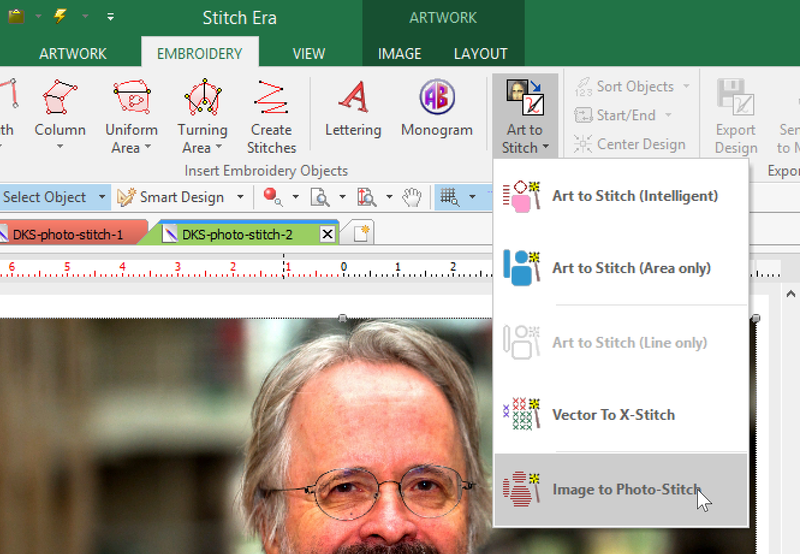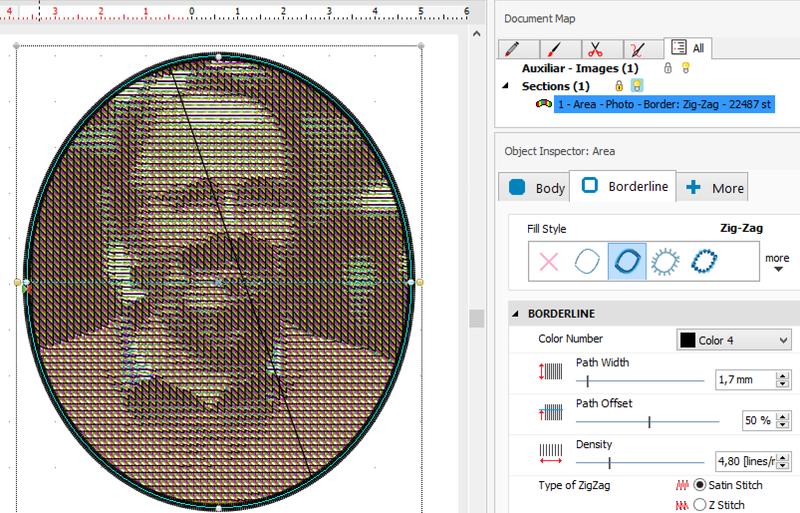Stitch Era - photo-stitching: Difference between revisions
(Created page with "{{embroidery|Intermedia tutorial}} {{Incomplete}} <!-- <pageby nominor="false" comments="false"/> --> == Introduction == This beginner's tutorial for the Stitch Era embroi...") |
mNo edit summary |
||
| Line 47: | Line 47: | ||
* Select the picture | * Select the picture | ||
* EMBROIDERY tab, select Art to Stitch -> Image to Photo-Stitch | * EMBROIDERY tab, select Art to Stitch -> Image to Photo-Stitch | ||
[[File:Stich-era-photo-stitch-1.png|thumb|800px|Photo Stitching tool]] | [[File:Stich-era-photo-stitch-1.png|thumb|800px|none|Photo Stitching tool]] | ||
'''Select an area''' | '''Select an area''' | ||
| Line 54: | Line 54: | ||
By default you will be able to select an area from the picture (click, click, click, .... and right-click accept). Alternatively, use a simple form in the Shapes menu to select an area, e.g. an oval, the click on <code>Confirm and Edit</code> | By default you will be able to select an area from the picture (click, click, click, .... and right-click accept). Alternatively, use a simple form in the Shapes menu to select an area, e.g. an oval, the click on <code>Confirm and Edit</code> | ||
[[File:Stich-era-photo-stitch-2.png|thumb|800px|After drawing an oval, confirm and Edit]] | [[File:Stich-era-photo-stitch-2.png|thumb|800px|none|After drawing an oval, confirm and Edit]] | ||
Before hitting confirm and Edit, you also could change parameters, but we suggest doing this later since you may need several attempts anyhow. | Before hitting confirm and Edit, you also could change parameters, but we suggest doing this later since you may need several attempts anyhow. | ||
| Line 60: | Line 60: | ||
Either in the ribbon panel on top or in the object manager, you now can play with all sorts of parameters. Before doing, so, untick <code> Auxiliar </code> on top right, so that you can better see the stitches. Hit F9 if you turned off automatic stitch generation. | Either in the ribbon panel on top or in the object manager, you now can play with all sorts of parameters. Before doing, so, untick <code> Auxiliar </code> on top right, so that you can better see the stitches. Hit F9 if you turned off automatic stitch generation. | ||
[[File:Stich-era-photo-stitch-3.png|thumb|800px|Parametrize a photo stitch era - Workspace shows default]] | [[File:Stich-era-photo-stitch-3.png|thumb|800px|none|Parametrize a photo stitch era - Workspace shows default]] | ||
Several parameters can be adjusted (hit F9 after each change if necessary) | Several parameters can be adjusted (hit F9 after each change if necessary) | ||
| Line 66: | Line 66: | ||
* Body pattern: You can choose between several color (Cyan-Magenta-Yellow-(Black) or white and black combinations. You even could exchange these base colors by others. | * Body pattern: You can choose between several color (Cyan-Magenta-Yellow-(Black) or white and black combinations. You even could exchange these base colors by others. | ||
* Stitch "cell" size, Both horizontal and vertical length can be adjusted. By default 2mm are used. In addition you could adjust the "line spacing" (row) size. It should not be too large (default is 0mm, i.e. there will be no empty space. | * Stitch "cell" size, Both horizontal and vertical length can be adjusted. By default 2mm are used. In addition you could adjust the "line spacing" (row) size. It should not be too large (default is 0mm, i.e. there will be no empty space. | ||
[[File:Stich-era-photo-stitch-4.png|thumb|800px|Parametrize a photo stitch era - Changed pattern to CMYK 1 and cell size to 1.5 x 1.5mm]] | * Color contrast: Defines how color bands will be translated to stitches. I do not really understand how this works. | ||
* Black Contrast (for either B/W por CMYK models): Black color will be added in the range of "darkness" defined by "From" to "To", i.e. the area between the two sliders. | |||
[[File:Stich-era-photo-stitch-4.png|thumb|800px|none|Parametrize a photo stitch era - Changed pattern to CMYK 1 and cell size to 1.5 x 1.5mm]] | |||
In addition, you could change other parameters, e.g. add a border line. | |||
[[File:Stich-era-photo-stitch-5.png|thumb|800px|none|Parametrize a photo stitch era - Border line]] | |||
== Links == | == Links == | ||
* [https://www.advanced-embroidery-designs.com/projects/guide_photostitch_lesson3.html Lesson 3 Multi-Color Photo Stitch Designs], retrieved oct 2017. | * [https://www.advanced-embroidery-designs.com/projects/guide_photostitch_lesson3.html Lesson 3 Multi-Color Photo Stitch Designs], retrieved oct 2017. | ||
Revision as of 18:37, 4 October 2017
Introduction
This beginner's tutorial for the Stitch Era embroidery software tries to explain how to create embroidery from photos through a method called photo-stitching.
Not to be confounded with Image stitching where a series of photos is stitched together to form a panorama picture.
- Tutorial home page
- Stitch Era embroidery software
- Learning goals
- Be able to select and prepare a photo-stitchable image
- Translate a picture
- Prerequisites
- Stitch Era embroidery software (in particular be able to create a new design).
- Stitch Era - creating embroidery from raster images
- Related pages
- none
- Materials
- You can reuse the pictures. In the wiki, click on picture to make it larger, then click again and save it.
- Quality and level
- Rough draft !
- Last major update
- Oct 2017.
Selecting a good picture
This procedure only works with a certain type of pictures
- The picture should have good contrasts,
- Its size should be between 10cm (1000px) and 16cm (1600px). Smaller will not work and bigger will run out of memory.
- The foreground (i.e. object to be identified in an embroidery) should well stand out.
Procecure
Enhance contrasts
- In a first step, try to enhance contrasts. In particular make sure that the foreground stands out as well as distinctive features of the foreground
- I suggest playing with contrast, saturation and brightness
- then reduce colors.
Create a digitized area
Select the picture, then enter photo stitching
- Select the picture
- EMBROIDERY tab, select Art to Stitch -> Image to Photo-Stitch
Select an area
As soon as you land in the "Area" tab you must select an area of the picture that will be stitched. You can choose to select a single area or several. Not selecting an area will not work. If you want to try digitizing a whole picture, just draw a rectangle from the Shape tool.
By default you will be able to select an area from the picture (click, click, click, .... and right-click accept). Alternatively, use a simple form in the Shapes menu to select an area, e.g. an oval, the click on Confirm and Edit
Before hitting confirm and Edit, you also could change parameters, but we suggest doing this later since you may need several attempts anyhow.
Play with the photo stitch parameters
Either in the ribbon panel on top or in the object manager, you now can play with all sorts of parameters. Before doing, so, untick Auxiliar on top right, so that you can better see the stitches. Hit F9 if you turned off automatic stitch generation.
Several parameters can be adjusted (hit F9 after each change if necessary)
- Body pattern: You can choose between several color (Cyan-Magenta-Yellow-(Black) or white and black combinations. You even could exchange these base colors by others.
- Stitch "cell" size, Both horizontal and vertical length can be adjusted. By default 2mm are used. In addition you could adjust the "line spacing" (row) size. It should not be too large (default is 0mm, i.e. there will be no empty space.
- Color contrast: Defines how color bands will be translated to stitches. I do not really understand how this works.
- Black Contrast (for either B/W por CMYK models): Black color will be added in the range of "darkness" defined by "From" to "To", i.e. the area between the two sliders.
In addition, you could change other parameters, e.g. add a border line.
Links
- Lesson 3 Multi-Color Photo Stitch Designs, retrieved oct 2017.




